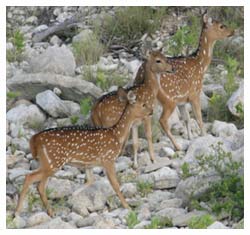Hunting Tips, Questions, Stories & Discussion
Focusing on managing Texas wildlife habitat and natural resources for native and exotic wild game species, for this and future generation of hunters and outdoor enthusiasts.Monday, June 29, 2009
What is the best way to prepare Texas Axis deer?
Regardless of how you choose to prepare Texas Axis deer meat is it important to not overcook this meat. It is best served medium to medium well, but never cooked all the way to well done. Well done venison is going to be both dry and tough, much more so than well done beef. This is largely due to the minimal fat and lack of marbling or distribution of fat through the lean muscle  tissue. Domestic animals have been bred to have fat and marbling while wild species are naturally lean and low fat.
tissue. Domestic animals have been bred to have fat and marbling while wild species are naturally lean and low fat.
What natural terrain is most favorable for hunting Texas Axis deer?
The Texas Axis deer is able to use their coloration to blend into the surroundings, especially around their favorite feeding locations. They tend to be found in the early morning and at dusk along the edge of wooden area, grazing out into open spaces. The background of the trees and wooded areas blends very well with their various shades of brown coats and the white spots further create a blending effect.
Since the nature preference for these deer is the wooded areas, feeders are typically placed just inside a clearing or along the inside edge of an opening. This natural placement of feeders encourages the natural behavior of the Texas Axis deer, but also draws them more into the open so hunters have a clearer line of sight for a shot.
Do the antlers of a Texas Axis deer grow each year or are they constantly on the bucks?
Like most deer, the Texas Axis deer bucks lose their antlers every year, according to when they were born. Every year the small buds, more specifically known as pedicels, start to grow in the spring, producing the first signs of antlers. These antlers are covered in velvet, which is rich in blood to nourish the growing cells within the antlers. When the antlers reach full size, which will vary from buck to buck, the blood supply is cut off due to hormonal changes as the rut approaches. This decrease in blood to the antlers causes the velvet to dry and the bucks rub their antlers against trees, rocks or shrubs to rid them of the old velvet.
At this point the antlers are in the best possible condition for a trophy mount. If the buck is not harvested over that season, in the winter the lack of blood to the antlers will result in a weakening of the bone structure at the skull, causing the antlers to actually fall off and the cycle to start again.
Labels: axis deer recipes, axis doe hunting, texas axis deer
Subscribe to Post Comments [Atom]
<< Home
Archives
December 2008 January 2009 February 2009 April 2009 May 2009 June 2009 July 2009 August 2009 September 2009 November 2009 December 2009 January 2010 February 2010 March 2010 July 2010 August 2010 October 2010 November 2010 December 2010 January 2011 July 2011 August 2011 September 2011 December 2011 January 2012 February 2012 September 2012 July 2014
Subscribe to Comments [Atom]



